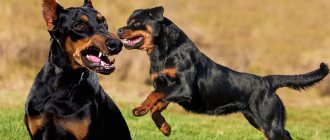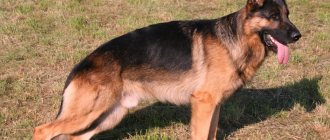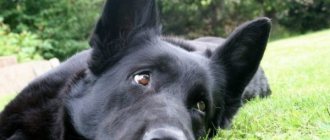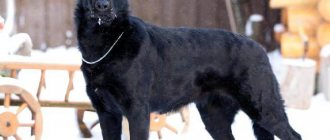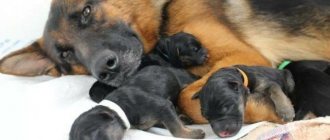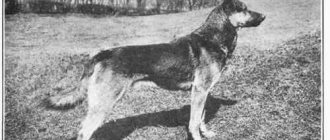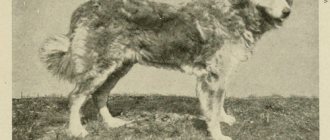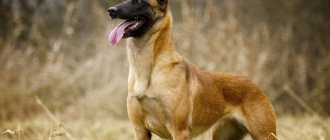Doberman or Rottweiler: who is stronger, who to choose, comparison
If the question is who to choose - a Doberman or a Rottweiler , it means that the person interested is choosing a serious dog with the function of a watchman and protector. When making a decision, psychologists advise studying all the facts, analyzing them and making a choice with your heart. Below you will find information for reflection and making the right decision.
Welsh Corgi dog breed: description, character, photo
Comparison of breeds
Taste is a subjective and personal matter, and therefore it is impossible to say who is better - a Doberman or a Rottweiler . The choice depends on several factors:
- For what purposes is a dog needed?
- Living conditions of the animal;
- The character of the future owner;
- Personal preferences.
Both breeds are quite large. They are united by their color - black (Dobermans have brown) with red tan in certain places. When choosing guard dogs, many often hesitate: who to choose - Doberman or Rottweiler . Sometimes a German Shepherd is added to this list. Dogs that are similar in appearance and functionality still have differences.
| Doberman | Rottweiler |
| Appearance | |
| Height: 70 cm (males), 65 cm (females) | 65 cm (males), 60 cm (females) |
| Weight: 46 kg (males), 36 kg (females) | 58 kg (males), 52 kg (females) |
| Large, slender, athletic, with a long muzzle | Massive and squat, with a wide muzzle and large jaw |
| Smooth coat without undercoat (keep outside impossible) | Smooth coat with undercoat (can live in an aviary) |
| Color black or brown with tan | Color black and tan |
| Character | |
| Choleric (temperamental, easily excited) | Phlegmatic (slow, serious, reserved) |
| Mobile nervous system | Calm and cool |
| Doesn't get along easily with other animals | Gets along well with other animals |
| Dominant | Assertive, fearless |
| Good learning ability | Easy to train |
| Regular training required | Education from an early age |
Who is stronger?
To answer the question of who is stronger - a Doberman or a Rottweiler , you need to take into account physical characteristics and temperament:
- Rottweilers have a powerful jaw and a strong grip and are popular as fighting dogs.
- Dobermans are nimble and agile with quick reactions.
- Rottweilers are smaller but heavier than Dobermans.
With these characteristics, both dogs have the same chances. This can be seen from the photo of the Doberman and Rottweiler . Both look intimidating, each in their own way.
Description of Doberman
A relatively young breed that appeared in Germany at the end of the 19th century.
Tax collector and policeman Friedrich Louis Dobermann from Thuringia decided to breed a guard dog with a formidable appearance for work needs.
At first the breed was called the Thuringian Pinscher, after the death of the founder it was renamed the Doberman Pinscher. Later, the prefix “pinscher” was removed, and the dogs began to bear the sonorous name of their “parent”.
The basis of the breed was the Old German Pinschers. Dog handlers have identified several more progenitors, including black and tan butcher dogs. The latter also appear in the pedigree of Rottweilers. As a result of selection, a dog was obtained with the following characteristics:
- Hardy;
- Vicious;
- Smart;
- Fighting character;
- Good instinct.
Modern Dobermans are somewhat different from their ancestors. Dobermann's successor, Otto Geller, worked on the dog's friendliness. Thanks to this, it has become popular not only as a police dog, but also as a family pet and companion.
The descendants of the Thuringian Pinscher have an aristocratic appearance, proud posture and graceful gait. The photo of a Doberman and a Rottweiler shows that the second does not have such an intelligent appearance, but compensates for this with other qualities.
Description of the Rottweiler
Rottweilers are one of the oldest breeds, descended from Molossian herding dogs. They entered German territory together with Roman legionnaires in 74 AD. e. In the Middle Ages it was used to protect livestock and property, and transport heavy loads. They became popular as “butcher dogs.” Rottweilers were valued for their qualities:
- Hardy;
- Trainable;
- Balanced;
- Good security guard;
- Smart.
Peasants were more interested in working ability than exterior beauty. All that was required from the dog’s appearance was a ferocious look. Therefore, the first representatives of the breed were overweight and awkward in appearance. To popularize Rottweilers, breeders worked on the dog's temperament and appearance. Modern descendant of Molossian dogs:
- Proportionally and harmoniously complex;
- Has excellent security qualities;
- Friendly and trainable.
Source: https://sobaken.org/doberman-ili-rotvejler-kto-silnee-kogo-vybrat-sravnenie/
History of the origin of the breed
The breed got its name from the German city of Rottweil, where it was bred. Dogs guarded the herds at night, drove up lagging cattle, and pacified raging bulls. Initially, dogs came to German territory along with the Roman conquerors. The invaders from Rome lived on the fertile lands for almost 200 years, and all this time they were accompanied by powerful and surprisingly hardy dogs, driving cattle and guarding herds of horses.
The Swabian tribes managed to drive out the invaders from their lands, but the dogs remained on German soil. The Germans appreciated the advantages and characteristics of the powerful breed and accepted them as guards of their herds.
In the 19th century, Rottweil butchers decided to improve the breed characteristics of the existing breed. Dogs began to be used as guard treasurers. The money received during the transaction was hung around their necks to ensure their safety. For these purposes, they crossed Roman dogs with local shepherd dogs. The result was dogs that are considered to be the ancestors of modern Rottweilers.
We recommend reading: How to Tame a Parrot to Handle If There Are Several of Them
Dog breeders at that time were not interested in the appearance of the resulting breed. The main goal of the breeders was to obtain dogs that perform the necessary service functions. Gradually, dogs began to be used for driving herds, guarding cargo and territory. Naturally, under the influence of external factors, dogs developed working qualities: power, endurance, courage, the ability to act decisively and quickly, and to show controlled aggression.
By the end of the 19th century, the need to protect herds disappeared, and Rottweilers were left out of business. The breed began to gradually disappear, and was saved only thanks to the organization of the Rottweiler Fans Club in Germany. Work has begun to restore the breed.
The Rottweiler is a caring pet, but at the same time an unsurpassed guard.
In England and the USA, the qualities of Rottweilers were appreciated and they began to be used as service dogs. They began to help police officers, firefighters, and rescuers. Rottweilers are still actively used in search and rescue operations around the world.
The exterior of the breed has not changed since that time, only the working qualities of the dogs have been improved. In the middle of the last century, Rottweilers won the title of caring pet, without losing the qualities of unsurpassed guards. The first representatives of the breed came to Russia in 1994.
Comparison of characteristics of the German Shepherd and Rottweiler
Often a person who wants to get a dog with guarding and protective qualities is faced with the problem of choosing which breed to choose: a German shepherd or a Rottweiler. Read also the article about mixed breeds of Rottweilers and German Shepherds.
Purpose of breeds
Of course, the German Shepherd and Rottweiler breeds are different from each other. These two dogs have one thing in common: they have working qualities and serve humans.
Purpose of the German Shepherd:
- She performs a service and guard function in the border troops,
- Used for detective work in the police during operational and anti-terrorism activities,
- Used by dog breeders to protect the house and property,
- Protects the owner and his family.
The purpose of the Rottweiler has the following variations:
- Used as a bodyguard to protect people,
- Used by the military to protect state borders,
- Can protect and guard the house, yard and all family members.
For inexperienced dog owners, it is preferable to use a German Shepherd for protection rather than a Rottweiler. It's all about the character and behavior of these pets. We'll talk about this a little later.
Appearance
Now let's look at the appearance of these two breeds. First, let's look at the exterior of the German Shepherd:
- The head is medium in size and wedge-shaped. The muzzle is elongated.
- The ears are set parallel to each other. Shepherd dogs with drooping and broken ears do not meet the standard.
- The eyes are usually brown or black and oval in shape.
- 42 teeth, scissor bite.
- The part where the back meets the pelvis has a slightly beveled shape.
- The chest is medium in size, as is the neck.
- Tail length is average. It is prohibited to cut it (cut it).
- The limbs are powerful and muscular.
- Dark colored nails.
- The coat is thick and long, with undercoat. The color has black, red, beige and gray shades.
- There are individuals with long hair.
As for the Rottweiler, it has the following appearance:
- The head is large, the cranial bones are massive, the muzzle is shorter than that of a shepherd dog.
- The frontal bone and nose are parallel to each other.
- The cheeks can sometimes be sagging and wrinkled.
- The nose is large and black.
- The eyes are also oval in shape and dark in color.
- The ears are hanging, in the form of a triangle.
- 42 teeth, scissor bite.
- The chest is extensive.
- The withers are well defined, the neck is massive.
- The limbs are powerful and muscular.
- The tail is shorter than that of a shepherd.
- The coat is very short, glossy and even.
- The color is almost charcoal, with slight transitions to a red color.
As you can see, both pets have a beautiful appearance and a noble appearance.
Weight and dimensions
Here are comparative data on the body proportions of a Rottweiler and a German Shepherd:
| Characteristic | Rottweiler | German Shepherd |
| Height | minimum – 60 centimeters, maximum – 70 centimeters | minimum – 55 centimeters, maximum – 65 centimeters |
| Weight | minimum – 50 kilograms, maximum – 60 kilograms | minimum – 30 kilograms, maximum – 40 kilograms |
| Build | large | average |
As you can see, the German Shepherd is inferior in size and build to the Rottweiler, but only slightly.
Character and behavior
In their character and behavior, animals differ significantly from each other. For example, the German Shepherd is famous for its intelligence and intelligence. She learns commands very quickly, but is not able to store them in memory unless she is regularly trained. After all, a dog’s brain constantly requires training.
In addition, the German Shepherd is calm and balanced and has good mental health. She loves physical activity, outdoor games and training.
From the first days of life, such a pet becomes attached to one person in the family and always remains faithful to him. This pet is very dependent on people and constantly requires attention.
In addition, the shepherd is a very friendly animal that is good with children and can become a nanny for them.
As for the Rottweiler, its character is a little different. This dog loves to be a leader in everything, is very stubborn, and can sometimes show aggression for no reason. Her reaction is very fast, her grip is strong.
Therefore, when strangers appear on its territory, the Rottweiler may attack people. His intelligence is also high, but such an animal can be trained reluctantly and with difficulty. The pet is independent and proud.
He takes a dominant position in teaching and may pretend to be sick just to avoid learning commands.
If you manage to tame a Rottweiler (and not everyone can do this), he will become a devoted pet who will fearlessly protect his owner and his family members. You need to approach training such a dog responsibly, find your own approach and do it with all your heart.
Who is stronger, Rottweiler or German Shepherd?
To draw a conclusion about who is stronger, a Rottweiler or a German Shepherd, it is necessary to compare these two breeds, which was done above. As can be seen from these comparisons, the Rottweiler has a larger build.
His grip is stronger than that of a German Shepherd. And by its nature it is a more aggressive animal. We can say that the Rottweiler is stronger than the German Shepherd. However, it is too early to draw conclusions.
After all, you can give a definite answer only by comparing specific pets.
Moreover, each breed has its own characteristics and each specific dog too. You need to choose which animal to get based on the qualities of a particular pet, based on your needs. The main thing is not to commit rash actions and weigh all the pros and cons before your pet gets into the family.
Comparison of characteristics of the German Shepherd and Rottweiler Link to main publication
Source: https://nemetzkaya-ovcharka.ru/razvedenie/rotvejler-i-nemetskaya-ovcharka
Comparison of dog breeds. Who is stronger: Rottweiler or German Shepherd
So, you need a reliable, smart and strong dog friend who can stand up for himself and protect you if necessary. These qualities are equally possessed by animals of two breeds - Rottweiler or German Shepherd - which one should you give preference to?
Description of the German Shepherd
The German Shepherd is of impressive size. The height of the animal is from 55 to 65 centimeters, weight - 30-40 kilograms. The female is slightly smaller in size than the male. Learn more about weight standards.
The dog has an attractive appearance. The body composition is proportional and harmonious.
The head is medium-sized, wedge-shaped. The facial part is well developed. The ears are triangular, pointed, and set wide apart. The eyes are dark and almond-shaped. The teeth are straight, the bite is correct.
The neck is of medium length, strong, the chest is of medium width, well developed. The back is straight.
The sacrum is slightly sloping - this is an important breed feature characteristic of the German Shepherd.
The tail is of medium length, straight, and cannot be docked.
The coat of the German Shepherd is thick, with abundant fluffy undercoat, and there are short-haired and long-haired individuals; its color is varied - black, combinations of red and brown with black, gray with black.
If you want to learn more about the RKF and FCI standards of this breed, then read here.
How are a German Shepherd and a Rottweiler similar?
- Both breeds were bred in Germany.
- Descended from herding dogs.
- They are large in size.
- Strong and resilient.
- The Rottweiler and the German Shepherd are good shepherds and guards.
How are they different?
The Rottweiler differs from the German in the following ways:
- The Rottweiler has a menacing appearance. Despite this, the animal has a balanced character and, in most cases, a stable psyche. Intelligence is high.
- There may be difficulties with training. This dog tends to make decisions on its own.
- In case of danger, he is easily provoked into aggression.
- Ideal as a personal bodyguard.
The German Shepherd differs from the Rottweiler in the following:
- The German Shepherd attracts attention rather than repels.
- Mentally stable. Trains well. She is sociable, assesses the situation well and is able to make independent decisions.
- Treats new acquaintances calmly. These qualities make it possible to use the animal in street patrols and search work. Tolerant of animals and children. The animal shows aggression only when necessary. Most often, on command or under a clear threat.
- The shepherd is a good watchman and assistant policeman.
Rottweiler or German Shepherd, who is better and who is stronger?
The Rottweiler is on average larger and more aggressive than the German Shepherd, and has a stronger jaw grip - a characteristic feature of the Molosser.
However, the German Shepherd has its own advantage : it acts less impulsively, more thoughtfully and purposefully.
A lot depends on the character and physical development of a particular animal.
German Shepherd vs Rottweiler: Tug of War
The German Shepherd and Rottweiler are loyal, intelligent pets.
Of course, there are more problems with Rottweilers , because Germans are more obedient and flexible in behavior.
Shepherd dogs are often used as service dogs in many areas: rescuers, security, border troops, army, police and much more. Rottweilers are not so versatile, they are more suitable for protection.
Source: https://lovegav.ru/nemetskaya-ovcharka/i-rotvejler.html
Which dog has the strongest jaws?
Since the force of compression of this dog’s jaw is equal to twenty-five atmospheres. When they bite, their jaw sometimes locks and they cannot always open it themselves. There have been cases where dogs were forced to open their jaws with a stick, because she herself could not always open her jaw. That’s why they hang and dangle like “rags” during a bite.
The dog is a shepherd dog, not very aggressive, but ready to defend its owners bravely and fearlessly. The bull dog used to go into the arena with the matador, so that in case of need, when he had a hard time, he could rush at the bull and turn attention to himself. During this time, he could get up and continue the fight with the bull, or he could be carried out of the arena in his arms.
Pit bulls, bull terriers, Rottweilers, mastiffs, Dobermans, Alabais, and Caucasian Shepherds can also boast enormous strength in their jaw muscles. Caucasians and Alabais are also especially scary due to their large weight.
One look at this dog is enough to convince you that this is a very serious dog. This is a dog with very strong muscles. It belongs to the category of fighting dogs, but at first it
And among domestic dogs, the competition is mainly between the Alabai, Tosa Inu, Pit Bull and Neapolitan Mastiff. The jaws of these dogs can create a pressure of 29-33. atmospheres
We recommend reading: Scabies In Dogs Symptoms and Treatment
The Mallorcan Bulldog has the strongest jaws. This breed is one of the rarest today. This dog even took part in the Spanish bullfight, helping matadors. The strength of its jaws is simply enormous, it allows it to cope with bulls.
These dogs began to appear in Russia not very long ago. The dogs have short hair, fairly compact sizes and an original appearance. Plus, to all this, they have a fairly calm disposition.
I remember that as a child I was struck by a story about a bulldog who grabbed a bear and, no matter how
Source
Who do you need: a Rottweiler or a Boxer?
A wonderful dog - a boxer, beautiful, athletic, strong. But the Rottweiler is a formidable athlete with powerful muscles. Which one should you choose to avoid making a mistake? You will understand which of these two dog breeds is right for you by comparing their characteristics. First, it’s worth finding out the characteristics inherent in these breeds in order to understand how they are similar and how they differ. To do this, you should decide for yourself why exactly you need a dog. A lot depends on your choice.
Similarities and differences
Outwardly they are very similar. Both have a forehead head with a flattened muzzle, small ears, a massive body, smooth fur that fits tightly to the skin. Both breeds are large, only the Boxer has a smaller variety.
And which of them is heavier, a Rottweiler or a boxer, is also not always clear. An adult Rottweiler is, of course, much heavier than a Boxer. But when it comes to young dogs, you can compete in weight categories. Now about the differences.
The Rottweiler strives to become a leader and subjugate a person, therefore it needs a strong and strong-willed owner. With proper training, he learns commands about the third time. A child should not have a Rottweiler, he will not be able to handle it.
The Boxer is a companion dog that recognizes command of a person immediately and unconditionally. In families with children, she shows all the signs of a nanny, caring for the owner’s children and protecting them. It is easy to raise, but it takes a very long time to learn commands - for boxers, childhood lasts up to about one and a half years.
Now that you have already formed your first impression of these breeds, let’s compare them based on the qualities that you would like to see in your future dog.
If you are a strong man who has a lot of free time and patience to raise a dog, you need a Rottweiler. If you live alone and have no children
Source
What are the similarities and differences between the East European and German Shepherd?
If you want to get a dog and the choice of breed is focused on shepherds, then you should know the difference between the German shepherd and the Eastern European and the similarities. Then you can easily understand who will suit the future owner. These two species have a number of unique distinctive features, knowledge of which will help you decide.
Origin of rocks
The German Shepherd (HO) was bred at the end of the 19th century. from herding dogs in the lands of Scandinavia. In a short time she gained fame in Europe.
In Germany, the breeding of such a dog has acquired a national scale. Selection was necessary to obtain ideal herding qualities and facilitate contact with people and other animals.
When the number of pastures decreased, they were involved in the security forces.
The East European Shepherd (VEO) appeared thanks to the breeding work of the USSR at the beginning of the 20th century.
When the need arose in the state for obedient dogs that could easily be trained, preference was given to the German Shepherd, which became the basis for a new species.
Selection work began to breed more powerful and hardy shepherd dogs, capable of withstanding the climatic conditions of a large country. This breed was not recognized until 2002, considering it a subspecies of the German one.
Difference between Shepherds
Selection and places of residence led to the formation of a number of characteristics of each breed.
Differences in dogs are expressed both in character and in appearance.
By appearance
- Back. A typical difference between a German Shepherd and an Eastern European is the ridge line. It gently descends to the tail at an angle of 23°. The Easterner has no spinal tilt.
- Size. The Vostochnik is noticeably larger than the German.
- Limbs. In a free stance, the hind legs of the VEO are slightly laid back, while those of the German Shepherd are quite far.
By temperament
German Shepherds are energetic, sociable, drawn to people, express emotions clearly, and are easily excited. Enjoying physical activity, they cope with sports training brilliantly.
Eastern Europeans are serious, have a calm disposition and self-control. They can be incredibly stubborn. They are smart and easy to train.
According to characteristics and standards
Each officially registered breed has compliance standards. Parameters may vary depending on the country of breeding.
NOVEO
| Height at withers/cm | 55-65 | 62-76 |
| Weight, kg | 22-40 | 30-60 |
| Back | Rolling | Rovnaya |
| Functions | Watchman, shepherd, bloodhound, participation in competitions | Guard, companion, guide |
| Color Black, zoned, black | Color Black, zoned, black |
How are dogs similar?
The German Shepherd was the basis for the emergence of both breeds, so the behavioral differences between the Eastern European and the German individual are relative.
Main similarities:
- developed intelligence;
- both dogs are easy to train and clearly follow commands;
- unconditional love and devotion to the owner;
- color
Types of colors
The following colors are found in both breeds:
- black-backed - a large dark area on the back in the shape of a mantle, descending to the elbows and sides and a mask on the muzzle;
- black is a rare color. Characterized by a solid coat color;
- zoned with tan marks – original color. The basis is a gray tone. A special feature is the ring coloring of the hair. The range of colors is varied.
Light and white wool, as well as plain red, is a defect in shepherd dogs. Such dogs are disqualified and not allowed to compete or breed.
Features of training
The East European Shepherd is reserved and serious. Classes are regarded rather as work that is done efficiently. Due to their mental stability, such dogs are taken for protection, as guide dogs, and for the border service. They only accept the owner and family members. They treat strangers with caution.
Training can be done by a person of any age and level of training; it is not necessary to be a professional. But the breed is not very suitable for competitions. A phlegmatic character and an overly serious attitude towards exercise complicate the process.
It will take much longer to achieve noticeable heights than with BUT.
For a German Shepherd, training looks like an entertaining game that brings delight. Training is easy. Such dogs are active, energetic, hardy, and capable of running long distances.
But sometimes they play around and take the exercises lightly. They are choleric and love people. You can often see these dogs at competitions, because the German copes with even the most difficult training complex.
Read more about training German Shepherds in this article.
The breeds are easy to train, but for competitions it is better to choose a German shepherd.
What is the difference between a German puppy and an Eastern European one?
A characteristic feature by which puppies can be distinguished is the line of the back.
In the German Shepherd it is distinctly inclined towards the base of the tail. The second breed has an almost perfectly straight line between the withers and the croup.
When comparing a German Shepherd puppy with an Eastern European one, it is noticeable that the latter are born large and gain weight faster. They resemble elephants, slow and clumsy. The girth of their metacarpus is significantly wider.
In this table you can see the height and weight of a German by month.
Price of puppies
Factors that shape prices include:
- title of parents, purebredness;
- age and health;
- color and compliance with standards;
- city;
- availability of a set of documents for the dog;
- reputation of the nursery.
In Russia, you can buy a German shepherd from 5 to 650 thousand rubles. (on average 30-35 thousand).
An East European Shepherd costs less - 3-75 thousand rubles. (average price – 20-30 thousand).
When choosing a dog, you need to consider the purpose of the establishment. If it is for the protection of private property, for a campaign for a lonely person or for playing with a child, then the puppy can be taken without a pedigree, not in the capital’s nursery. This will have a good effect on the price.
If the plans include breeding, participation in exhibitions and competitions, then saving can only do harm.
The place of breeds in the modern world
The German Shepherd is accepted by society and continues to gain popularity. Breeders all over the world maintain the quality of the breed at the highest level, so finding a purebred puppy that meets the standards is not difficult.
The East European Shepherd is less in demand. The Fédération Cynologique Internationale recognized the breed only in 2002. At a certain point, the population of the breed practically disappeared, but thanks to breeders and enthusiasts it was restored again. This species is distributed only in the CIS countries.
The opinion of dog handlers
The German Shepherd, from the point of view of dog handlers, is suitable for people who are partial to active leisure, long and frequent walks, and sports games. With good training, a German Shepherd puppy will grow into an excellent dog.
Those who live in a private home, need a watchdog, and lead a leisurely lifestyle should choose the Eastern European breed. A dog of this size will not be comfortable in a small apartment space. Lack of personal territory can lead to aggression towards people in close proximity.
The physical development of young individuals of this species occurs quickly and weight increases rapidly (this especially applies to East European Shepherds, which are larger from birth). Therefore, they are not recommended to jump over the barrier until they are fully mature.
Comparing the characteristics of the breeds, it becomes clear that the German Shepherd is suitable for active families with children and fans of sports competitions, while the Eastern European can become a faithful companion for a calm, balanced person or a guard for a suburban area.
But the choice must be made based on your lifestyle and goals for getting a dog.
